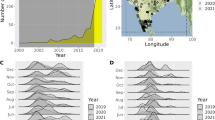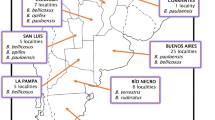Summary and conclusions
Mutillid parasites,Pseudomethoca frigida (Smith), were frequently found in a nest aggregation ofLasioglossum zephyrum (Smith), and were observed in combat with the bees, thereby indicating their importance (and that of parasites and predators in general) in the evolution of nest guarding and supporting Michener's hypothesis that one of the important factors in the evolution of social behavior was the opportunity for defense by guards in nests containing more than one bee. Nesting aggregations may have evolved in several ways, one being selection of bees nesting in areas already proven successful. Such selection might be expected where subtle environmental differences are critical, and may take the form of return to the parental nest sites or joining some other nest aggregation. Aggregation probably increases parasite and predator pressure, thus perhaps providing the necessary selective pressure for colony formation with nest guarding, as well as providing the potentiality for colony formation by allowing females to enter different nests. The seemingly greater success in nest defense by larger colonies suggests that this is one of of the factors responsible for the evolution of increased colony size. The behavior of the bees in nest defense and of their mutillid parasites is described.
Résumé
Des parasites mutillides ont été souvent trouvés dans une agglomération de nids deLasioglossum zephyrum (Smith) et ont été observés en train de combattre les abeilles, ce qui permet de souligner leur importance (et celle des parasites et des prédateurs en général) dans l'évolution de la garde du nid et qui confirme l'hypothèse deMichener, selon laquelle un des facteurs importants dans l'évolution du comportement social est la possibilité de défense par des gardes dans les nids contenant un nombre d'abeilles supérieur à un.
Les agglomérations de nids peuvent avoir évolué de différentes manières, l'une étant le choix de sites dans les aires, qui se sont déjà révélées propices. Une telle sélection peut être attendue là où des différences subtiles dans le milieu sont décisives. Elle peut prendre la forme d'un retour aux sites de nidification des parents ou le choix de n'importe quelle autre agglomération. Il est probable que l'agglomération augmente le nombre des parasites et des prédateurs et, par le fait même, procure peut-être la pression sélective nécessaire pour la formation de colonies avec gardiennage du nid. De même, l'agglomération procure aussi la possibilité de formation de colonies en donnant aux femelles l'occasion d'entrer dans différents nids. Le plus grand succès apparent dans la défense du nid par les colonies de plus grande taille suggère qu'il s'agit d'un des facteurs responsables de l'évolution de la colonie vers une augmentation.
Le comportement des abeilles durant la défense du nid et celui de leurs parasites est décrit.
Zusammenfassung
Die parasitische Mutillide,Pseudomethoca frigida (Smith), wurde mehrfach in den Kolonien vonLasioglossum zephyrum (Smith), beobachtet, als sie in Kämpfe mit diesen Bienen verwickelt war. Die einschlägigen Beobachtungen weisen auf die Wichtigkeit dieser, als auch anderer Parasiten und Räuber in der Evolution des Wächterwesens innerhalb der Bienen hin, indem sie Hypothese vonMichener unterstutzen, die besagt, dass einer der grundlegenden Faktoren fur die Entwicklung sozialen Verhaltens die Möglichkeit war ein Nest durch Wächter verteidigen zu können. Dies ist natürlich nur dann der Fall, wenn mehr als eine Biene im Nest vorhanden ist. Nisten im Verband, d. h. Nest-Ansammlung mögen sich auf verschiedenen Wegen entwickelt haben. Einer davon war die Selektion von Bienen, die immer bereits «erprobte» Nistplatze zum Nesten benützen. Eine derartige Selektion kann in solchen Fällen erwartet weredn, in denen geringfügige Unterschiede in den Umweltfaktoren für das Nisten entscheidend sind. Diese Selektion mag dann zur Rückehr zu den Geburtsplätzen oder zum Nesten in fremden Kolonierverbänden führen. Die Nester in Kolonierverbänden sind sicherlich Parasiten und Räubern erhöht ausgesetzt. Der entsprechende Selektiondruck mag dann nicht nur zur Formung von Kolonie mit einem organisierten Waechterwesen geführt haben, sondern auch die Möglichkeit mit eingeschlossen haben, dass die Bienenweibchen auch benachbarte Nester besuchen können. Der augenscheinlich grössere Erfolg in der Nestverteidigung im Falle von grösseren Kolonien weist darauf hin dass der erstere einer der Faktoren ist, die für die Evolution von grösseren Nestansammlungen ausschlaggebend sind.
Das Verhalten der verteidigenden Bienen und das ihrer parasitischen Multilliden ist beschrieben.
Similar content being viewed by others
Literature Cited
Krombein (K. V.), 1938. — Notes on the biology ofPseudomethoca frigida (Smith) (Hymenoptera, Mutillidae).Bull. Brooklyn Ent. Soc.,33, p. 14–15.
Melander (A. L.) andBrues (C. T.), 1903. — Guests and parasites of the burrowing beeHalictus.Biol. Bull.,5, p. 1–27.
Michener (C. D.), 1958. — The evolution of social behavior in bees.Proc. Tenth International Congress of Entomology, Montreal,2, p. 441–447.
Michener (C. D.), Lange (R. B.), Bigarella (J. J.) andSalamuni (R.), 1958. —Factors influencing the distribution of bees' nests in earth banks.Ecology,39, p. 207–217.
Michener (C. D.) andLange (R. B.), 1958a. — Distinctive types of primitive social behavior among bees.Science,127, p. 1046–1047.
Michener (C. D.) andLange (R. B.), 1958b. — Observations on the behavior of Brazilian halictid bees (Hymenoptera, Apoidea). I.Pseudagapostemon.Ann. Ent. Soc. Amer.,51, p. 155–164.
Michener (C. D.) andLange (R. B.), 1958c. — Observations on the behavior of Brazilian halictid bees, III.Univ. Kansas Sci. Bull.,39, p. 473–505.
Michener (C. D.) andLange (R. B.), 1958d. — Observations on the behavior of Brazilian halictid bees. V.Chloralictus. Insectes Sociaux,5, p. 379–407.
Michener (C. D.) andWille (A.), 1961. — The bionomics of a primitively social bee,Lasioglossum inconspicuum.Univ. Kansas Sci. Bull.,42, p. 1123–1202.
Rayment (T.), 1937. — Biology of a new halictine bee and specific descriptions of its parasites.Arbeiten ü. physiol. u. angewandte Ent. aus Berlin-Dahlem,4, p. 30–59.
Rayment (T.), 1947. — Biology and taxonomy of the solitary bee,Parasphecodes fulviventris (Friese).Australian Zoologist,11, p. 76–95, pls. vii–x.
Sakagami (S. F.) andMichener (C. D.), 1962. —The nest architecture of the sweat bees. Univ. Kansas Press, Lawrence, p. 1–135.
Author information
Authors and Affiliations
Additional information
I am indebted to Dr.C. D. Michener of The University of Kansas for constructive criticism of this paper. I wish to thank him also for identification of the bee and Dr. ClaranceMickel of the University of Arizona for identification of the mutillid.
Rights and permissions
About this article
Cite this article
Lin, N. Increased parasitic pressure as a major factor in the evolution of social behavior in halictine bees. Ins. Soc 11, 187–192 (1964). https://doi.org/10.1007/BF02222936
Issue Date:
DOI: https://doi.org/10.1007/BF02222936




